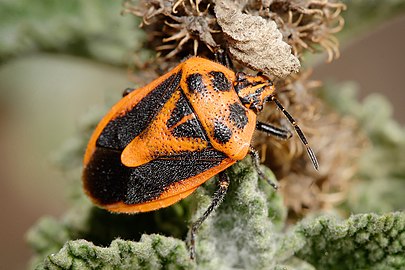Agonoscelis
| Agonoscelis | |
|---|---|

| |
| A. erosa in South Africa | |
| Scientific classification | |
| Kingdom: | Animalia |
| Phylum: | Arthropoda |
| Class: | Insecta |
| Order: | Hemiptera |
| Family: | Pentatomidae |
| Tribe: | |
| Genus: | Agonoscelis Spinola, 1837 |
Agonoscelis is a genus of stink bugs that are native to the Afrotropics and Australia, but one species is established in the New World. Some species are minor[1] or considerable pests.[2]
They have five nymphal stages, and are 8 to 12 mm long as adults. They attack (or control) weeds and herbs including horehound, thyme, flax and cotton, or the developing seeds of sunflowers or cereals like millet or sorghum.[3] They may swarm on a variety of other shrubs and trees, including coffee and cacao.[2] The scent gland is located at the end of the abdomen.
Species[]
There are some 19 to 22 species, which include:[4][5]
- (Westwood, 1837)
- A. e. atropurpurea Schumacher, 1913
- Walker, 1868
- F. – Flower head bug
- Agonoscelis puberula Stål, 1853 – African cluster bug (established in New World)
- Agonoscelis pubescens (Thunb.) – Andat bug, Sudan dura bug, Pentatomid sorghum bug, African cluster bug, syn. A. versicolor (Fabricius, 1794)
- Agonoscelis rutila (Fabricius, 1775) – Horehound bug
- (Turton) – Sunflower seed bug

A. rutila

A. versicoloratus
References[]
- ^ Weaving, Alan; et al. (2004). Field guide to insects of South Africa (New ed., updated ed.). Cape Town: Struik. p. 138. ISBN 978-1-77007-061-5.
- ^ a b "Agonoscelis puberula". tsusinvasives.org. Texas Invasive Species Institute. Retrieved 15 October 2014.
- ^ Slater, Randall T. Schuh, James A. (1996). True bugs of the world (Hemiptera:Heteroptera): classification and natural history (2. printing. ed.). Ithaca [u.a.]: Comstock. p. 35. ISBN 0801420660.
- ^ "Agonoscelis Spinola, 1837". biolib.cz. Biolib. Retrieved 15 October 2014.
- ^ compiled; SA, edited by Derwent Publications Ltd with the assistance of CIBA-GEIGY (1990). Thesaurus of agricultural organisms: pests, weeds and diseases (1st ed.). London: Chapman and Hall. p. 26. ISBN 0412372908.
{{cite book}}:|first2=has generic name (help)
Categories:
- Pentatomidae
- Pentatomomorpha genera
- Pentatomoidea stubs

